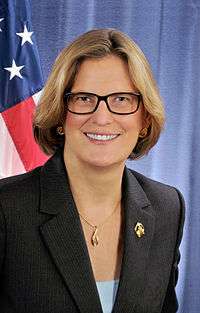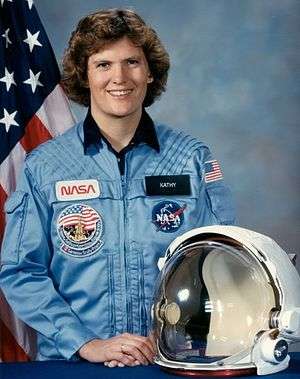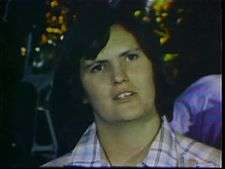Kathryn D. Sullivan
Kathryn Dwyer Sullivan (born October 3, 1951 in Paterson, New Jersey) is an American geologist and a former NASA astronaut. A crew member on three Space Shuttle missions, she is the first American woman to walk in space. She is the current Under Secretary of Commerce for Oceans and Atmosphere and Administrator of the National Oceanic and Atmospheric Administration after being confirmed by the U.S. Senate on March 6, 2014.
Education
Sullivan is a 1969 graduate of William Howard Taft High School in the Woodland Hills district of Los Angeles, California. She was awarded a Bachelor of Science degree in Earth Sciences from the University of California, Santa Cruz in 1973, and a Ph.D. in Geology from Dalhousie University in 1978.[1] While at Dalhousie, she participated in several oceanographic expeditions that studied the floors of the Atlantic and Pacific oceans.[2]
Military career
In 1988, Sullivan joined the U.S. Naval Reserve as an oceanography officer, retiring with the rank of captain in 2006. She has served as chief scientist for the National Oceanic and Atmospheric Administration. Before NASA, Sullivan worked in Alaska as an oceanographer.
NASA career
Sullivan performed the first extra-vehicular activity (EVA) by an American woman during Space Shuttle Challenger mission STS-41-G on October 11, 1984. Sullivan and mission specialist David Leestma performed a 3.5-hour space walk in which they operated a system designed to show that a satellite could be refueled in orbit.[2] During their eight-day mission, the crew deployed the Earth Radiation Budget Satellite, conducted scientific observations of the earth with the OSTA-3 pallet (including the SIR-B radar, FILE, and MAPS experiments) and large format camera (LFC), conducted a satellite refueling demonstration using hydrazine fuel with the Orbital Refueling System (ORS), and conducted numerous in-cabin experiments as well as activating eight "Getaway Special" canisters. STS-41G completed 132 orbits of the Earth in 197.5 hours, before landing at Kennedy Space Center, Florida, on October 13, 1984.
In April 1990, Sullivan served on the crew of STS-31, which launched from Kennedy Space Center, Florida, on April 24, 1990. During this five-day mission, crew members aboard the Space Shuttle Discovery deployed the Hubble Space Telescope, and conducted a variety of middeck experiments involving the study of protein crystal growth, polymer membrane processing, and the effects of weightlessness and magnetic fields on an ion arc.[3] They also operated a variety of cameras, including both the IMAX in-cabin and cargo bay cameras, for earth observations from their record setting altitude of 380 miles. Following 76 orbits of the earth in 121 hours, STS-31 Discovery landed at Edwards Air Force Base, California, on April 29, 1990.[3]
 Astronaut Kathryn Sullivan checks SIR-B antenna during STS-41-G |
 Astronaut Kathryn Sullivan using binoculars to view the earth during STS-41-G |
Dr. Sullivan served as Payload Commander on STS-45, the first Spacelab mission dedicated to NASA's Mission to Planet Earth. During this nine-day mission, the crew operated the twelve experiments that constituted the ATLAS-I (Atmospheric Laboratory for Applications and Science) cargo.[3] ATLAS-I obtained a vast array of detailed measurements of detailed measurements of atmospheric chemical and physical properties, which will contribute significantly to improving our understanding of our climate and atmosphere. In addition, this was the first time an artificial beam of electrons was used to stimulate a man-made auroral discharge.[3]
Sullivan left NASA in 1993.[2] She flew on three space shuttle missions and logged 532 hours in space.[1]
Civilian career

After leaving NASA, Sullivan served as president and CEO of the COSI Columbus, an interactive science center in Columbus, Ohio and as Director for Ohio State University's Battelle Center for Mathematics and Science Education Policy as well as a volunteer science advisor to COSI. Under her leadership, COSI strengthened its impact on science teaching in the classroom and its national reputation as an innovator of hands-on, inquiry-based science learning resources.[4] She was appointed to the National Science Board by President George W. Bush in 2004.
In 2009, Sullivan was elected to a three-year term as the chair of the Section on General Interest in Science and Engineering for the American Association for the Advancement of Science.
In January 2011, the White House sent to the Senate the nomination of Sullivan by President Barack Obama to be an assistant secretary of commerce. Sullivan was first nominated in December 2010, but because the Senate did not approve her nomination and a bevy of others forwarded late in December, the White House renewed the formal requests.
On May 4, 2011, Sullivan was confirmed by unanimous consent of the U.S. Senate and appointed by President Obama to serve as Assistant Secretary of Commerce for Environmental Observation and Prediction and Deputy Administrator for the National Oceanic and Atmospheric Administration.[5]
Sullivan was appointed as Acting Under Secretary of Commerce for Oceans and Atmosphere and Acting NOAA Administrator on February 28, 2013.[6]
Sullivan was confirmed by the Senate as the Under Secretary of Commerce for Oceans and Atmosphere and NOAA Administrator on March 6, 2014.[7]
Awards and other recognition
In 1991, Sullivan received the Haley Space Flight Award for "distinguished performance in the deployment of the Hubble Space Telescope on Mission STS-31 during April 1990."[8]
In 2004, Sullivan was inducted into the Astronaut Hall of Fame and received the Adler Planetarium Women in Space Science Award.
In 2014, Sullivan was honored in the Time 100 list. According to John Glenn, "Kathy is not just an ivory-tower scientist. She was part of NASA's first class of female astronauts, selected in 1978, and went on to fly three shuttle missions. She is the first American woman to walk in space and served aboard the mission that deployed the Hubble Space Telescope. That role in helping humanity look outward has not prevented her from looking homeward. The planet is suffering increasingly severe upheavals, at least partly a result of climate change — droughts, floods, typhoons, tornadoes. I believe my good friend Kathy is the right person for the right job at the right time."[9]
In May 2015, Kathryn D. Sullivan was awarded an honorary doctorate from Brown University for her "abundant contributions to science, education and the public good, and her ongoing commitment to improving the state of our planet for future generations."[10]
In September 2015, Dr. Sullivan presented the John H. Glenn Lecture in Space History Series at the Smithsonian National Air and Space Museum in Washington, D.C. Titled "Looking at Earth: An Astronaut's Journey," Sullivan discussed her life of exploration and discovery, what it’s like to fulfill her childhood dreams, and how NOAA’s study of our planet helps us understand today’s environmental challenges.[11]
In 2016, Sullivan was chosen to receive the Rachel Carson Award from The National Audubon Society for her environmental leadership.
Notes
| Wikimedia Commons has media related to Kathryn D. Sullivan. |
- 1 2 "Astronaut Bio: Kathryn D. Sullivan (04/2014)". nasa.gov.
- 1 2 3 "Kathryn Sullivan". Encyclopedia Britannica.
- 1 2 3 4 "Sullivan". astronautix.com.
- ↑ "NASA Biographical Data". Retrieved 22 May 2015.
- ↑ "National Oceanic and Atmospheric Administration". Retrieved 4 May 2011.
- ↑ "National Oceanic and Atmospheric Administration". Retrieved 4 June 2013.
- ↑ "National Oceanic and Atmospheric Administration". Retrieved 10 May 2014.
- ↑ "American Institute of Aeronautics and Astronautics". Retrieved 4 January 2015.
- ↑ "The 100 Most Influential People". Retrieved 21 May 2015.
- ↑ "Brown awards six honorary doctorates - News from Brown". brown.edu.
- ↑ "Smithsonian National Air and Space Museum: John H. Glenn Lecture in Space History Series". Retrieved 24 January 2016.

